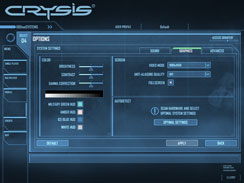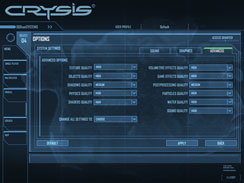Crysis
Publisher: Electronic ArtsWhat can we say about this game that hasn’t been said already? Crysis is probably the most anticipated game on the PC this year and was released on November 16th.
Crysis is seen by many as the poster boy for DirectX 10 and it will make your system cry, quite literally – it’s a monster! It doesn’t come as much of a surprise then, that the graphics are something special – they’re above and beyond anything we’ve ever seen in a PC game.
We tested the game under both DirectX 9.0 and DirectX 10 using a custom timedemo and is more representative of gameplay than the built-in benchmark, which renders things much faster than you’re going to experience in game. We found that around 25 fps in our timedemo was sufficient enough to obtain a playable frame rate through the game. It’s a little different to other games in that the low frame rates still appear to be quite smooth.
For our testing under DirectX 9.0, we set most of the in-game settings to high, with the only exceptions to this rule being shadow quality and post processing quality, which were dropped to medium quality. For DirectX 10 testing, we set shader quality to 'very high', while all other settings remained the same as what they were set to for our DX9 performance testing. Because of how intense the game is, we tested with both anti-aliasing and anisotropic filtering disabled for the time being. There is currently no support for anisotropic filtering in the game, but you can still force it from the driver control panel.
DirectX 9.0
DirectX 10.0
Crysis is a system killer—there are no two ways about that—but that doesn’t mean you can’t get decent enough performance from a Radeon HD 3870 or GeForce 8800 GT. As Sapphire’s card is merely a reference card dressed up in Sapphire’s clothes, it’s no surprise that it performs in the same ballpark as the Gigabyte card we used for our single card testing in our original Radeon HD 3870 review.
Under DirectX 9.0, the Radeon HD 3870 is around five to eight percent slower than the GeForce 8800 GT, which isn’t bad considering the difference in price. The best part of it all is that you’ll get playable frame rates at both 1280x1024 and 1680x1050 with 0xAA enabled and with most of the settings turned up to ‘high’. Our tests were done with only shadow and post processing quality turned down to ‘medium’.
When you start playing around with DirectX 10, performance does drop a bit and you’ll struggle to get above 30 frames per second even at 1280x1024 on Sapphire’s Radeon HD 3870. With all settings, except the shader quality (which was turned up to ‘very high’), remaining the same as they were in our DirectX 9.0 tests, the Radeon HD 3870 is around 14 percent slower than the GeForce 8800 GT at both 1280x1024 and 1680x1050 – that’s the difference between smooth gameplay and not-so-smooth gameplay at 1280x1024 on these cards.

MSI MPG Velox 100R Chassis Review
October 14 2021 | 15:04











Want to comment? Please log in.